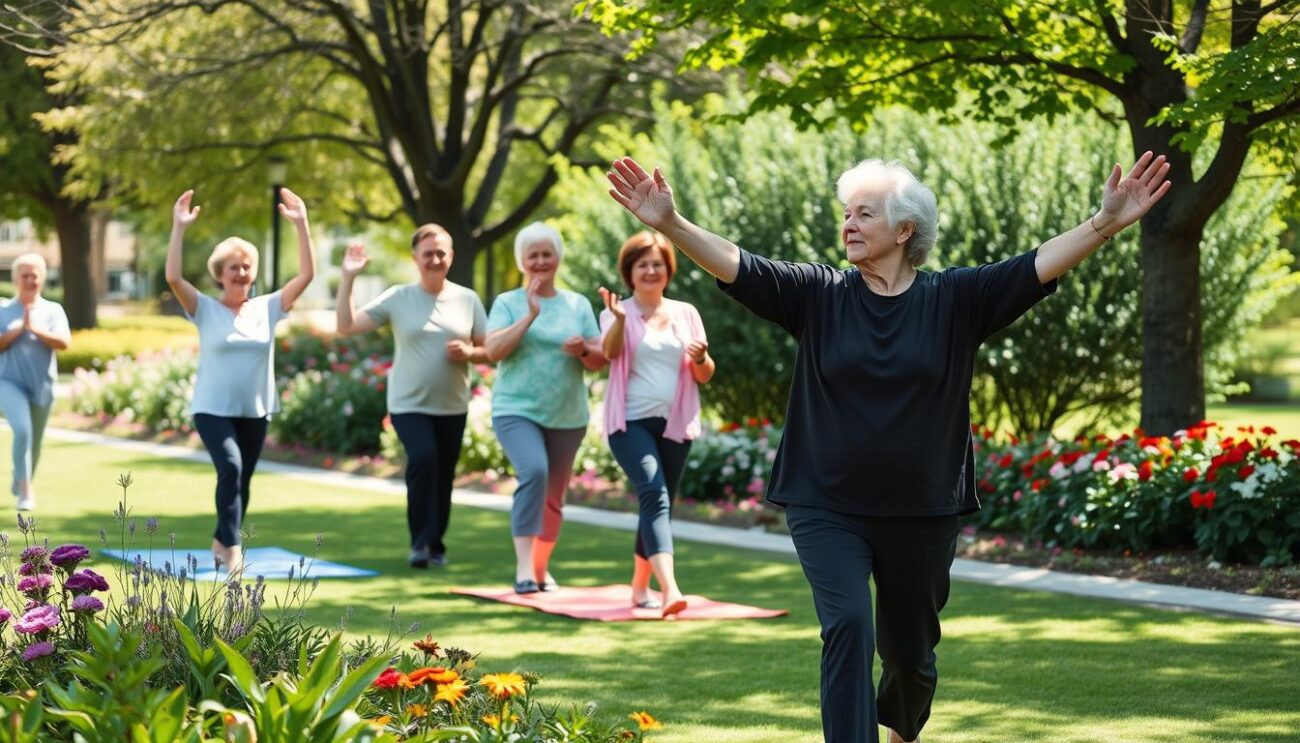Did you know the best exercise for lowering blood pressure might surprise you? A recent study found that isometric exercises like planks, squats, and bridges work best for those with high blood pressure. But why are these exercises so effective, and how can you add them to your routine? Let’s dive into the surprising benefits of isometric training and how it can help control high blood pressure.
Key Takeaways
- Isometric exercise training was found to be the most effective form of exercise for lowering blood pressure in a study of over 15,000 participants.
- Engaging in isometric exercises can help lower inflammation, improve endothelial function, enhance the body’s response to stress, and boost heart efficiency.
- The American Heart Association recommends 150 minutes of moderate-intensity exercise or 75 minutes of vigorous aerobic activity per week to maintain healthy blood pressure.
- Gradually increasing exercise intensity is crucial for individuals with hypertension to monitor their heart rate and breathlessness.
- Consulting with a healthcare professional before starting a new exercise program is advised for adults with chronic conditions.
Importance of Controlling Blood Pressure
Keeping blood pressure healthy is key for your overall well-being. High blood pressure, or hypertension, can cause heart attacks, strokes, and kidney disease. It’s vital to control blood pressure to avoid these serious health issues.
Chronic High Blood Pressure and Health Risks
In Canada, over 1 in 5 people have high blood pressure. By 2025, it’s expected to affect up to one-third of adults worldwide. High blood pressure is a major cause of death, responsible for 13.5% of all deaths.
It increases the risk of heart problems, which can double with every 20 mm Hg increase in blood pressure.
Traditional Suggestions for Lowering Blood Pressure
To lower blood pressure, a healthy lifestyle is recommended. This includes regular exercise, a diet low in sodium, and following the DASH diet. The American Heart Association suggests 150 minutes of moderate exercise or 75 minutes of vigorous activity weekly.
If lifestyle changes aren’t enough, medications might be needed to help lower blood pressure.
“Making lifestyle changes is a long-term journey and may feel challenging, but support groups can lift spirits and offer practical tips to cope with high blood pressure.”
Relationship Between Exercise and Blood Pressure
Exercise is key to keeping blood pressure healthy. Many studies show how exercise can lower blood pressure. It does this by reducing body inflammation, improving blood vessel function, and better handling stress.
Exercise relaxes arteries and makes the heart work better. This improves blood flow and lowers blood pressure.
How Exercise Lowers Blood Pressure
Regular exercise greatly affects blood pressure. The American College of Cardiology and the American Heart Association found it can lower blood pressure by 4 to 12 mm Hg diastolic and 3 to 6 mm Hg systolic. Losing just 5 pounds can also lower blood pressure for those who are overweight.
Doing at least 150 minutes of moderate aerobic activity or 75 minutes of vigorous aerobic activity weekly can manage high blood pressure. Mixing aerobic and weight training exercises is best for heart health. It takes 1 to 3 months for exercise to lower blood pressure noticeably.
Short breaks to stretch and move each hour can also help. It’s important to watch heart rate during exercise to avoid injury. Always talk to a healthcare provider before starting an exercise program, especially if you have health conditions like hypertension.
Regularly checking blood pressure, including at home, helps track the effects of exercise. Studies show both aerobic and resistance training exercises are good for blood pressure. They help both resting and ambulatory blood pressure.
Isometric Exercise Training for Hypertension
If you want to lower your blood pressure, isometric exercise training might be the solution. This workout involves contracting muscles without moving the joints much. It’s been shown to be the best exercise for lowering high blood pressure.
What is Isometric Exercise?
Isometric exercises are a type of strength training. They involve contracting muscles without moving the joints much. Examples include wall sits, planks, and calf raises. These exercises can help lower both systolic and diastolic blood pressure.
Benefits of Isometric Exercise for Blood Pressure
A new study of 270 studies found isometric exercises are the most effective for lowering blood pressure. The study, published in the British Journal of Sports Medicine, looked at 15,827 participants. It found isometric exercise training has the biggest impact on reducing resting blood pressure.
The study showed different exercises have different effects on blood pressure:
- Aerobic exercise training: -4.49 mm Hg (systolic) and -2.53 mm Hg (diastolic)
- Dynamic resistance training: -4.55 mm Hg (systolic) and -3.04 mm Hg (diastolic)
- Combined training: -6.04 mm Hg (systolic) and -2.54 mm Hg (diastolic)
- High-intensity interval training: -4.08 mm Hg (systolic) and -2.50 mm Hg (diastolic)
- Isometric exercise training: -8.24 mm Hg (systolic) and -4.00 mm Hg (diastolic)
Isometric exercise training was found to be the most effective for lowering both systolic and diastolic blood pressure. It had a SUCRA value of 98.3% for systolic blood pressure.
Isometric exercise can help lower blood pressure by improving blood vessel function and reducing stress in the body. Always talk to a doctor before starting a new exercise routine, especially if your blood pressure is very high.
best exercise for hypertension
If you want to lower your blood pressure, try isometric exercises. These exercises make your muscles work without moving your joints. Studies show they can lower both your systolic and diastolic blood pressure.
Effective Isometric Exercises for Hypertension
Here are some top isometric exercises for lowering high blood pressure:
- Wall sits or wall squats: Stand with your back against a wall, feet shoulder-width apart, and slide down the wall as if you’re sitting in a chair. Hold this position for 30-60 seconds.
- Planks: Hold a high plank position, engaging your core muscles, for 30-60 seconds.
- Isometric bicep curls: Hold a weight in each hand with your arms bent at a 90-degree angle, keeping your elbows tucked close to your sides, and hold for 30-60 seconds.
- Isometric shoulder presses: Hold weights above your head with arms extended, engaging your shoulder muscles, for 30-60 seconds.
Research shows isometric exercises can lower blood pressure more than other types of exercise. Doing these exercises a few times a week can help manage hypertension and boost your heart health.
Combining Exercise with Other Lifestyle Changes
Exercise, especially isometric training, is great for lowering blood pressure. But it works best when you also make other lifestyle changes. These include eating well, staying at a healthy weight, drinking less alcohol, and managing stress. Making these changes can really help lower blood pressure and prevent serious health problems.
Studies show that exercise and lifestyle changes are especially good for people with resistant hypertension. The TRIUMPH trial had 140 people with resistant hypertension. Ninety got weekly diet and exercise help, while 50 got just a single session on healthy living. The group getting help saw their blood pressure drop by 12 mm Hg on average.
The group getting help also saw big drops in blood pressure over 24 hours. They had better health markers for heart disease than the group that didn’t get help. This shows how important it is to combine exercise with other lifestyle changes for hypertension management.
By taking a full approach, people with high blood pressure can see big health gains. This might mean:
- Eating a balanced, low-sodium diet to stay at a healthy weight
- Doing regular physical activity, like isometric exercises and aerobic workouts
- Drinking less alcohol
- Using stress management techniques, like meditation or yoga
Adding these lifestyle changes to your exercise routine can lead to even bigger blood pressure drops. It can also lower your risk of heart disease. By looking at your whole health, you can feel better and live better.
Aerobic Exercise for Hypertension
Isometric exercises aren’t the only game in town when it comes to lowering blood pressure. The American Heart Association suggests at least 150 minutes of moderate aerobic activity or 75 minutes of vigorous activity weekly. Some top aerobic exercises for hypertension include:
- Walking
- Jogging
- Cycling
- Swimming
- Dancing
A meta-analysis found a big drop in blood pressure after just 4 weeks of aerobic exercise. Regular aerobic workouts also improve blood vessel health in those with hypertension. Plus, aerobic interval training can lower blood pressure and boost heart function in hypertensive patients.
| Aerobic Exercise | Impact on Blood Pressure |
|---|---|
| Walking | Reduced systolic and diastolic blood pressure by 5.94 and 2.66 mmHg, respectively, in people with hypertension. |
| Biking | Shown to reduce blood pressure in various populations, including men and women aged 18 to 75-plus years, with or without hypertension. |
| Swimming | Led to lower cholesterol, blood glucose, blood pressure, body mass index, and body fat percentage after moderate and low-intensity sessions. |
Doing aerobic exercise for hypertension can greatly help manage high blood pressure and boost heart health.
“Aerobic interval training results in decreased blood pressure and enhanced myocardial function in hypertensive patients.”
Resistance Training for Hypertension
Aerobic exercises like walking and swimming are good for blood pressure. But, resistance training also helps lower blood pressure. It builds muscle and boosts heart health, which can reduce blood pressure.
A 2011 study by Cornelissen VA found that resistance training is effective. It included 950 people and showed clear benefits. This exercise can help with blood pressure and heart health.
In 2013, Cornelissen VA looked deeper into exercise and blood pressure. This study combined data from many sources. It showed how resistance training can help with hypertension.
To get the most benefits, do strength training two times a week. Weightlifting in sets of 8 to 12 reps is safe and effective. Lifting moderate or heavy weights is better than light weights for blood pressure.
| Exercise | Description | Benefits for Hypertension |
|---|---|---|
| Squats | Stand with feet shoulder-width apart, engage core, and lower into a sitting position as if you’re sitting back into a chair. | Strengthens the legs and improves overall cardiovascular fitness, contributing to lower blood pressure. |
| Bicep Curls | Stand with a dumbbell in each hand, palms facing up, and bend elbows to bring the weights towards your shoulders. | Builds upper body strength and muscle mass, which can aid in managing hypertension. |
| Overhead Press | Hold a weight at shoulder height with both hands, then press it straight overhead, extending your arms. | Strengthens the shoulders and core, improving overall cardiovascular fitness and blood pressure control. |
Resistance training alone may not lower blood pressure enough. But, it’s great when combined with a healthy diet and regular exercise. Always talk to a doctor to create a plan that fits your needs.
Low-Impact Workouts for Hypertension
For those with hypertension, low-impact workouts are a great option. Yoga, walking, and swimming are good choices. They offer heart benefits without hardening your joints.
Yoga for High Blood Pressure
Yoga can help lower blood pressure. It combines poses, breathing, and meditation. This makes it a good choice for those with high blood pressure.
Walking for Hypertension
Walking is a great low-impact exercise. It can help lower blood pressure over time. Adding brisk walks to your day can be very effective.
Swimming for Hypertension
Swimming is also good for those with hypertension. It’s an aerobic exercise that can lower cholesterol and blood sugar. It’s a refreshing way to improve heart health.
Adding these low-impact workouts to your routine can help lower blood pressure. They improve heart health without straining your body too much.

Conclusion
Keeping blood pressure healthy is key for a long and good life. The best exercise for hypertension is isometric training. It’s been proven to lower blood pressure the most.
But, combining isometric exercises with a healthy diet, managing weight, and reducing stress is best. This mix helps those with high blood pressure the most.
Adding different types of exercises, like aerobic and resistance workouts, helps manage hypertension. Regular exercise lowers blood pressure and improves heart health.
It’s important to talk to a doctor before starting any new exercise plan, especially if you have high blood pressure. The right mix of exercise, diet, and lifestyle changes can help lower blood pressure. This improves overall health and well-being.





